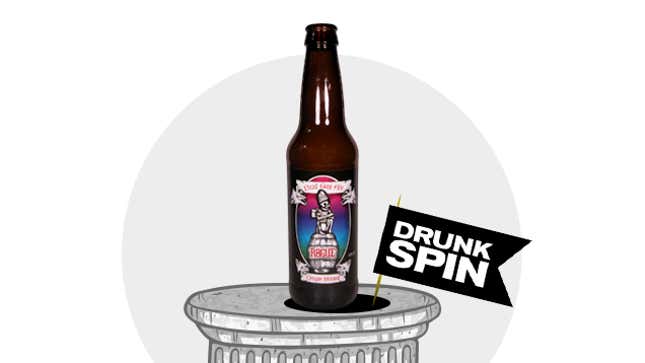
Friends, pay no mind to your calendars, with their equinoxes and solstices and pictures of dogs dressed for various atmospheric conditions. Disregard their months and days and stubborn refusal to learn where the apostrophe goes in Presidents' Day. None of that matters in determining just what time of year it is. Your phone will let you know when your midsummer dentist appointment is, and the sports and sunsets will hip you to the rest.
They're playing baseball on TV now, and we jimmied with the clocks yesterday, which means it's spring. And it's a darn good thing we have sports and manually enhanced daylight to let us know what season it is, because this is one of the very few areas in which beer is of no help. Time was, you could tell it was spring because the spring beers were out. These days, however, most of the better breweries have split the year into eight or 10 capriciously calculated micro-seasons that bear little resemblance to our traditional understanding of the passage of time.
In fact, many of the very newest breweries don't even pretend to follow the seasons anymore. There seems to be an emerging trend of just issuing a ceaseless stream of special-edition beers, which debut as one-timers but tend to eventually get reclassified as part-timers, full-timers, or never-againers depending on consumer reaction. I respect this approach; no need to plan the wedding or file the restraining order before the first date.
Reluctance to commit to a traditional seasonal release schedule, though rational, is a little bit frustrating for consumers. I loved the Jack's Abby's Berliner-Style Lager I had last summer, but I guess I just have to wait it out a few months and then draw my own conclusions as to whether that first batch was worth the brewer's time and effort. I respect that, though. It's a reasonable way for a brewery to manage consumer demand for more, newer, better beers every damn week.
For a lot of new places, it must seem like every damn time they turn the beer machine on in the morning, it's to make a new "pilot batch" of something that will get people back in the door. Medusa Brewing in Central Massachusetts opened their doors to the public for the first time about 48 hours ago; they had eight frigging beers on tap. Budweiser, which has been around for 139 years, probably won't introduce their eighth different style of beer until Peanut Butt-Er-Ita hits the shelves next fall. But modern beer aficionados are fickle as fuck.
Which is why we don't deserve nice things, such as regularly scheduled beer releases that serve as our own personal thermometers and star charts. Most of the previous generation of craft brewers—the ones that came to prominence in the 1990s and the first decade of this century—still release seasonals, but they do it whenever and however they please. The spring beers will get here when they get here (a few blizzards ago, in most cases), and they'll be whatever damn style the brewery is looking to unload at the time.
My favorite style of spring beer is German maibock, also known as helles bock, a seasonal subset of the bock style of strong lager. Maibocks are lighter in color and hoppier in flavor than other bocks, though the German versions still aren't very hoppy by current American standards.
Oregon's Rogue Ales and Spirits has been pumping out a wide range of beers since 1988. A lot of their marketing—I mean, their corporate ethos—centers on revolutions and manifestos and pledges to always take risks and innovate and, one presumes these days, fuckin' disrupt. That part of their game isn't for me. Neither are their line of donut-flavored stouts and other silly gimmicks. Tell you what, though: Their year-round maibock, Dead Guy, is very much for me.
First, a caveat: Rogue has yet to catch on the revolutionary idea of dating their bottles, so a consumer, and particularly one on the other side of the country, is rolling the dice any time he buys one of their beers. I've had some great ones and some ugly ones, and I do not recommend buying a Dead Guy from any but the most trustworthy of sources. In fact, Rogue's stubborn refusal to date their beers is such bullshit that you could be forgiven for just refusing to take the leap under any circumstances. Freshness matters a ton!
That said, I got my hands on a newborn Dead Guy recently, so I'll tell you about the pleasures that await if you gamble and win.
Rogue Dead Guy is brewed with five different malts: two-row, C15, Munich, and a couple of the ones they grow on their own farm. That's a cool approach that leads to rich, complex aromas of bread, caramel, and light fruit; you can also smell a bit of peppery spice from their proprietary Pacman yeast and/or the two house-label hops employed for balance. When you stop sniffing and start drinking, the fruit character deepens and the spice is joined by an herbal note and a gently bitter pine vibe.
Rogue Dead Guy can be a damn good beer, but only if the body's still warm. It's one of the best domestic maibocks if you catch the right bottle, and I'll leave it for you to decide if that sounds like a risk worth taking.
This is Drunkspin Daily, the Concourse's adequate source for booze news, reviews, and bullshit. We'll be highlighting a beer a day in this space; please leave suggestions below.
Will Gordon loves life and tolerates dissent. He lives in Cambridge, Mass., and some of his closest friends have met Certified Cicerones. Find him on Twitter @WillGordonAgain. Image by Jim Cooke.
The Concourse is Deadspin's home for culture/food/whatever coverage. Follow us on Twitter.